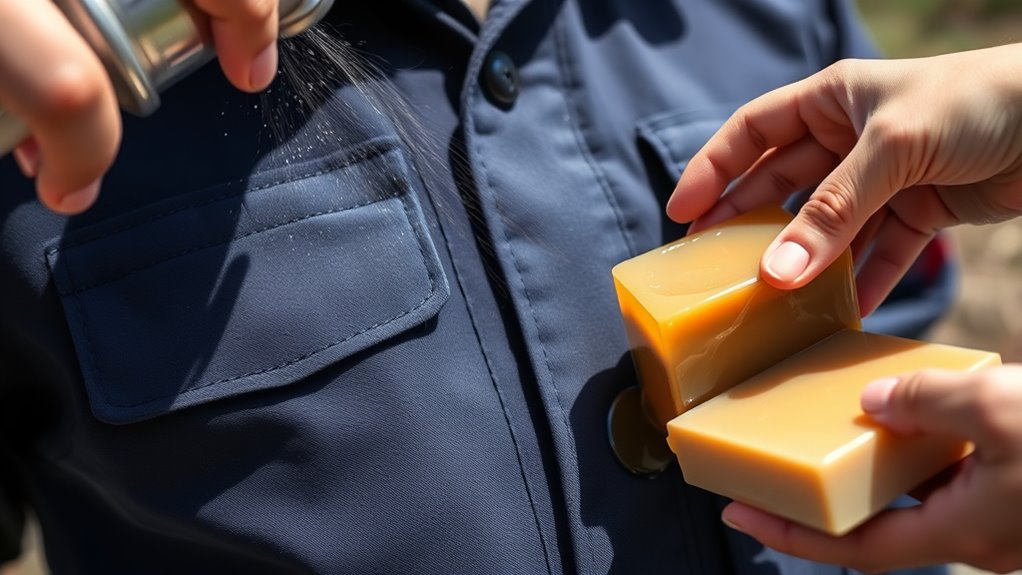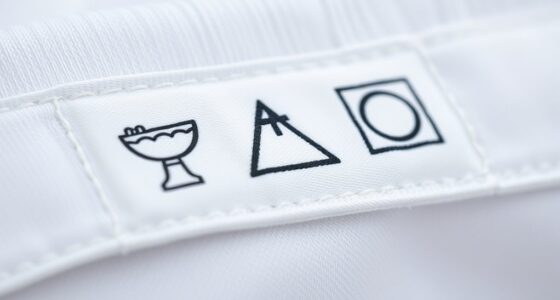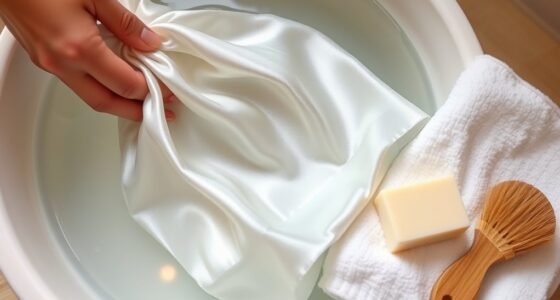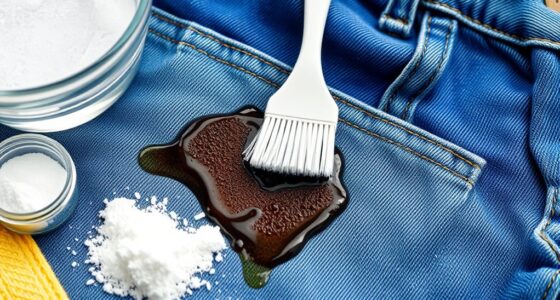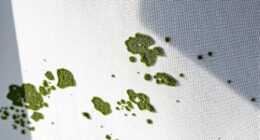To waterproof fabric using spray and wax techniques, start by cleaning and drying your fabric thoroughly. For spray-on waterproofing, shake the can well and apply an even coat from about 6-12 inches away, paying special attention to seams and zippers. For wax, warm it until pliable, then evenly spread it on the fabric using a cloth or sponge, working it into seams. Gently heat the fabric to set the wax. If you want more tips, you’ll find useful details ahead.
Key Takeaways
- Clean and dry the fabric thoroughly before applying spray or wax waterproofing treatments.
- Use a suitable spray designed for fabrics, holding 6-12 inches away, and apply an even coat covering all areas.
- For wax, warm it to soften, then evenly apply with a cloth or sponge, focusing on seams and folds.
- Gently heat the waxed fabric with a hairdryer to bond the wax and improve flexibility and water resistance.
- Regularly reapply spray or wax treatments to maintain waterproofing as wear and washing diminish effectiveness.

Waterproof fabric techniques are essential for creating durable and water-resistant materials used in outdoor gear, apparel, and equipment. When it comes to waterproofing, your choice of fabric treatments can make all the difference. There are various methods, but spray and wax techniques are two of the most popular for adding an extra layer of protection. Before diving into these methods, it’s important to dispel some waterproofing myths. Many believe that once a fabric is treated, it will last forever. However, waterproofing isn’t a one-time fix. Over time, exposure to abrasion, dirt, and repeated washing can diminish its effectiveness. Knowing this helps you maintain your gear properly and reapply treatments as needed.
Spray-on waterproofing products are user-friendly and convenient. You simply clean your fabric first, making sure it’s dry and free of debris. Then, shake the spray can well and hold it about six to twelve inches from the surface, applying an even coat. Be sure to cover all areas thoroughly, especially seams and zippers, which are common weak spots. Once applied, let the fabric dry completely before use. This method is great for quick touch-ups or treating small items. It’s important to choose a spray designed specifically for your fabric type—some sprays work better on nylon or polyester, while others are suitable for leather or canvas. Always follow the manufacturer’s instructions for best results.
Waxing is another effective waterproofing technique, especially popular for outdoor gear like jackets, tents, and boots. You start by cleaning and drying your fabric thoroughly. Then, warm the wax slightly to make it more pliable. Using a cloth or sponge, apply the wax evenly across the surface, making sure to work it into seams and folds. Heating the fabric gently with a hairdryer afterward helps the wax bond better and creates a more flexible, water-resistant layer. Waxing provides a natural, breathable barrier that can be reconditioned as needed. It’s a traditional method that enhances the durability of your gear and gives it a classic, rugged look. Additionally, understanding the properties of different waterproofing treatments can help you choose the most suitable method for your specific needs.
Incorporating these waterproofing techniques into your routine ensures your gear stays dry and functional. Remember that proper maintenance and reapplication are key to preserving the effectiveness of your fabric treatments. While waterproofing myths suggest that one treatment will last forever, reality is different—continuous care and timely re-treatments keep your outdoor gear performing at its best. By understanding these methods and avoiding common misconceptions, you can confidently protect your gear against the elements and extend its lifespan.
Frequently Asked Questions
How Long Does Waterproofing Treatment Last on Different Fabrics?
The waterproofing treatment on fabrics typically lasts between 1 to 6 months, depending on fabric durability and exposure to elements. If you use spray or wax techniques regularly, you’ll notice the treatment’s longevity diminishes faster on more durable fabrics or those exposed to frequent washing or harsh conditions. To maintain waterproofing, reapply treatments as needed, especially before heavy rain or frequent use, to guarantee maximum protection.
Can Waterproofing Sprays Be Used on Delicate or Vintage Fabrics?
Yes, you can use waterproofing sprays on delicate fabrics and vintage textiles, but you need to be cautious. Test the spray on a small, hidden area first to check for any damage or discoloration. Use a gentle, fabric-specific spray and follow the manufacturer’s instructions carefully. Avoid oversaturating to preserve the fabric’s integrity, especially with vintage textiles, which can be more fragile and sensitive to chemical treatments.
Is It Safe to Wash Waterproofed Fabric in a Regular Washing Machine?
Washing waterproofed fabric in a regular machine isn’t a catastrophe, but it can compromise the waterproofing if you’re not careful. You should avoid harsh detergents and fabric dyes that might strip away waterproofing chemicals. Instead, use a gentle cycle and mild detergent designed for waterproof or delicate fabrics. Always check the care label and reapply waterproofing treatments if needed, because even the strongest waterproofing can wear down over time.
Are There Eco-Friendly Waterproofing Options Available?
Yes, eco-friendly options for waterproofing fabrics do exist. You can choose sustainable waterproofing methods like plant-based waxes or water-repellent coatings made from natural materials. These eco-friendly options minimize environmental impact while still providing effective protection. By opting for sustainable waterproofing, you contribute to environmental conservation and guarantee your fabric stays water-resistant without relying on harmful chemicals. Look for brands that prioritize eco-conscious ingredients and sustainable practices.
How Do I Maintain Waterproofing Effectiveness Over Time?
To maintain waterproofing effectiveness, you should regularly reapply your waterproofing product to keep fabric breathability and waterproofing durability intact. Clean the fabric gently to remove dirt and debris before re-coating, ensuring a proper seal. Store items in a cool, dry place to prevent damage. Consistent care, like spot treatments and inspections, prolongs the waterproof barrier, keeping your fabric dry and protected through all adventures.
Conclusion
By mastering these methods, you’ll make your fabric flawlessly waterproof and worry-free. Whether you choose spray or wax, the process is simple and satisfying. Stay consistent, and your fabric will withstand weather’s worst whims. With waterproofing wisdom, you ward off water woes and welcome weather resilience. Remember, waterproofing is a wise, wonderful way to preserve your prized possessions and prepare for unpredictable environments. Waterproofing wonders await when you work with willpower and wit!

